The 25 Most Amazing University Sculptures
By RJH Berland
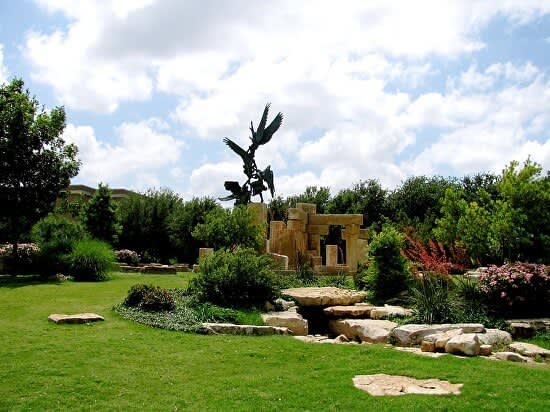
An aesthetically pleasing campus can enhance the university experience significantly, and great sculpture adds to the beauty. The criteria for this particular selection of the 25 most interesting sculptures at universities is expansive, however the list is by no means comprehensive. It provides a glimpse into the diversity of art collections at universities and includes contributors ranging from Native American artists to masters of modern art such as Auguste Rodin and Aristide Maillol. The neo-classical works of Bertel Thorvaldsen and Edward Onslow Ford are included as a way to pay tribute to the importance of classicism in higher education today, and to recognize the foundation of ancient culture served for artistic creativity throughout the ages. There are examples of non-figural Avant-garde artists such as Archipenko and masters of the monumental and industrial including David Smith, Richard Serra, and Melvin Edwards. You will also find the revisionist feminist sculptures of Louise Bourgeois and Kiki Smith. There are select examples of nonwestern sculpture from Africa, India, and South America, representing the richness of artistic traditions throughout the world. Finally, in an attempt to remark on the fact that sculptural achievement is often a combination of formal prowess as well as thoughtful and intellectually charged content, I have included work of lesser-known artists such as Donal Hord, Gabriel DiShaw, and Jack Maxwell. These artists may not be world renown but deserve inclusion because their technical accomplishments are astounding and provocative and because the content of their work is equally compelling.
25. Aztec
San Diego State University, California
Sculptor: Donal Hord

San Diego University commissioned the American artist Donal Hord (1902-1966) to make this five-foot tall black diorite sculpture, Aztec (1936-1937). A lifelong collector of nonwestern art, Hord suffered rheumatic fever as a child and lived as an invalid for most of his life, unable to attend school. Yet, despite these troubles, this highly skilled artist studied in San Diego with Anna Valentien, a former student of Rodin, and became a master at direct carving. Hord meticulously carved this work from a single 2.5-ton block over a period of 14 months. The stone was quarried from nearby Escondido. As seen in this sculpture, Hord's harmonious style often incorporated influences from Aztec traditions, Asian sculpture, and Cubism.
24. The Great God Pan
Columbia University, New York
Sculptor: George Grey Barnard

The accomplished American sculptor George Grey Barnard (1863-1938) was a renowned collector of medieval sculpture and architectural fragments; his collection formed the basis of the Cloisters, The Metropolitan Museum of Art, New York. Barnard studied at the Art Institute of Chicago as well as the Ecole des Beaux-Arts, Paris. This work is among his many mythological and allegorical figural bronze sculptures, combining influences of Rodin and French neoclassicism. The sculpture was cast by Henry-Bonnard Bronze Company, New York.
23. King Solomon
University of Philadelphia, Philadelphia, Pennsylvania
Sculptor: Alexander Archipenko
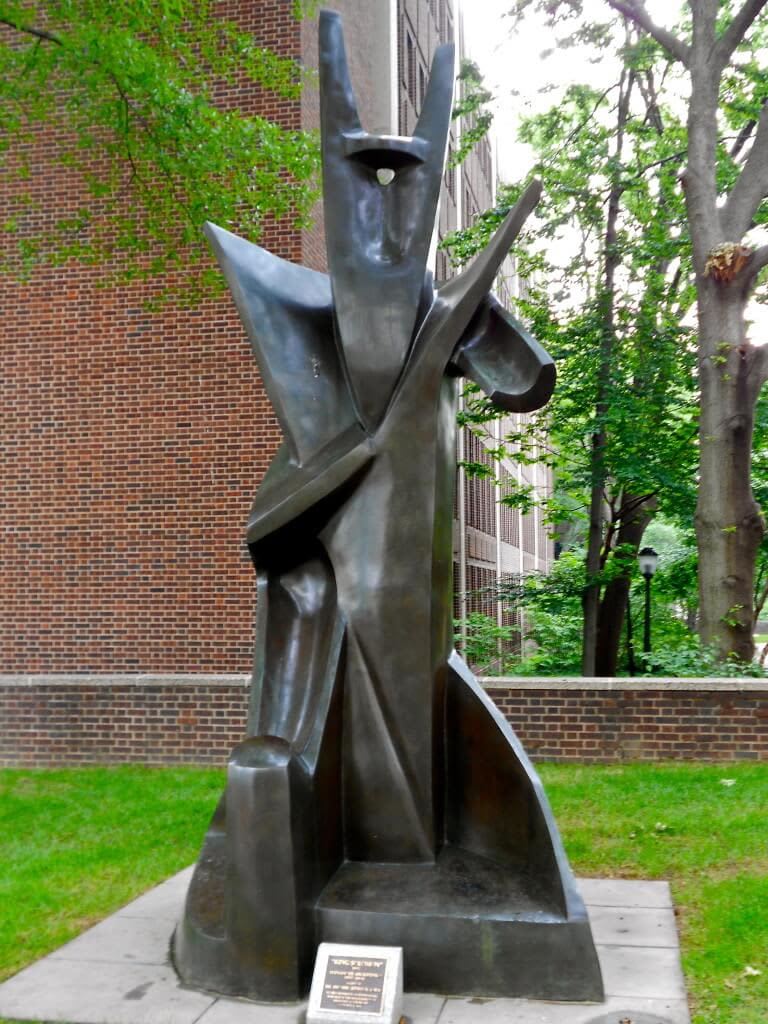
Long considered a master of Cubist sculpture, Ukrainian artist Alexander Archipenko (1887-1964) studied in Kiev and Paris, and worked in France and the United States. He exhibited with the Cubists in Paris in 1910, and was a founding member of La Section d'Or. This cast bronze depicts an abstract Cubistic figure, and as an example of Archipenko's work cast in bronze, it serves as a model for the sculptural ideal of abstract modernism. Throughout his career, Archipenko taught and lectured at universities, and served as a source of knowledge and inspiration to developing artists. This was his last sculpture.
22. Lord Byron
Trinity College, Cambridge University, England
Sculptor: Bertel Thorvaldsen
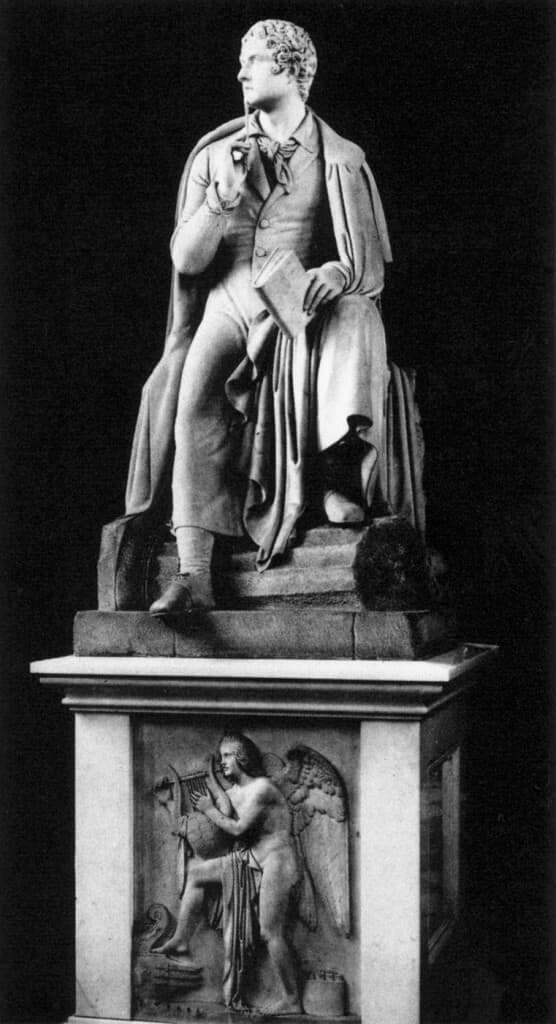
Danish sculptor Bertel Thorvaldsen (1770-1844) was greatly admired for the beauty and adroit rendering of his neoclassical sculpture. After the death of Canova, he was considered the preeminent sculptor, and in fact, his studio in Rome was a site of pilgrimage for his many devotees. Despite Thorvaledsen's reputation as a talented artist, when this majestic carved marble work of the notorious Lord Byron (1829-1835) was commissioned by the poet's friends for Westminster Abbey, Byron's profligate reputation preceded him, and it was refused and eventually made its way to the Wren Library at Cambridge. Thorvaldsen's refined and precise method of carving is evident in this work. It is an example of portraiture in the most classical sense.
21. Little Seed
University of Notre Dame, Sculpture Park, Indiana
Sculptor: Peter Randall-Page
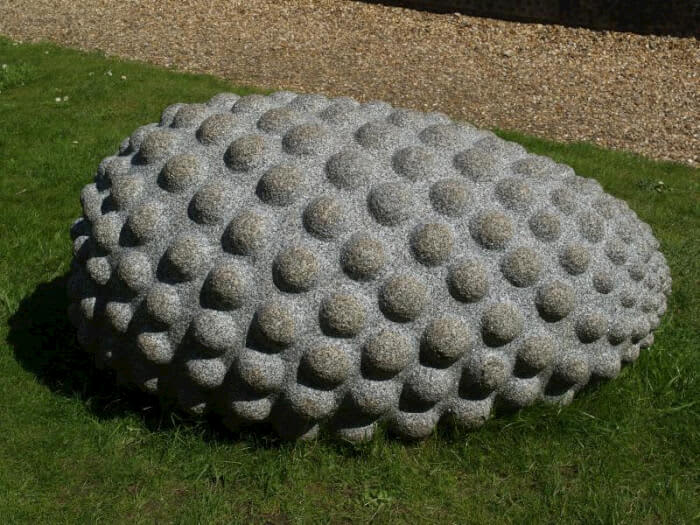
Peter Randall-Page (b.1954) is a British sculptor whose inventive and ingenious direct carving often calls on imagery from the natural world. This enigmatic work Little Seed (2007) is on view in the newly inaugurated Sculpture Park at Notre Dame. It is part of a larger installation of sculptures from the Snide Museum. The site is a former landfill, and now with the installation of a group of sculptures in a natural regenerating and indigenous landscape, it is a mysterious place of beauty. Part of a larger series of sculptures of seeds, Little Seed is a granite sculpture measuring 25 x 51 x 33. The artist based his design on the growth pattern of plants, spiral phyllotaxis. For Randall-Page, this pattern or phenomenon is visually and mathematically fascinating, and he says the only example in nature of the golden proportion in growth patterns.
20. Parliament of Reality
Bard College, New York
Sculptor: Olafur Eliasson

Danish artist Olafur Eliasson (b.1967) designed this outdoor installation Parliament of Reality (2009) for the Bard Campus. The work is to be enjoyed by the students. Through the use of enclosure and openness, the industrial materials and the natural space surrounding the concrete and stone island, it is a place of rest and study. In this permanent installation, Eliasson creates a dialogue between the worlds of nature and the urban. The artist's oeuvre consistently deals with themes of the natural world, the ephemeral, and technology using elemental materials in sculpture, installations, and other mechanics. Eliasson's interest in ecology, phenomenology, technology, science, weather, the interactions of space and the senses, and concepts and experiences of "inside and outside," as well as sound, has made for a diverse and intellectually engaged body of work.
19. Cubi XX
University of California Los Angeles, California
Sculptor: David Smith
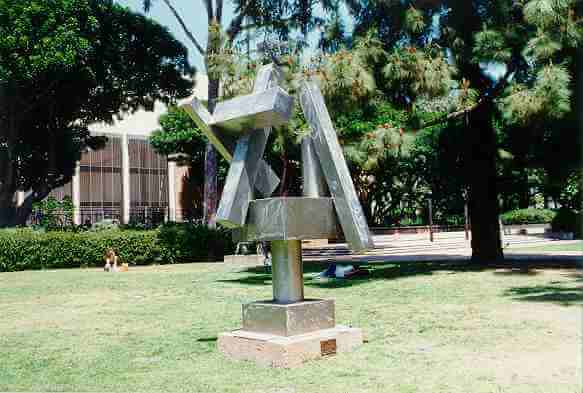
Renown for his abstract metal sculptures, American artist David Smith (1906-1965) began painting, but transitioned to sculpture in the 1930s, first making organic and geometric works, reflecting the influences of Pablo Picasso, Julio Gonzalez, and Alberto Giacometti. Later, Smith would learn to weld metal, often producing his works in an industrial manner. However, his work invariably shows a painterly touch. This geometric sculpture Cubi XX (1964) is from Smith's 1960s Cubis series. Made of welded stainless steel it stands 111 inches tall. In this work, we see the hand of the artist in the burnishing of the steel. Of the process of producing metal sculpture Smith said: "I now know that sculpture is made from rough externals by rough characters or men who have passed through all polish and are back to the rough again." Smith's influence is wide ranging, particularly in the United States and Britain, where sculptors continue to produce large-scale welded work in the same vein.
18. Southern Sunrise
Winston-Salem State University, North Carolina
Sculptor: Melvin Edwards
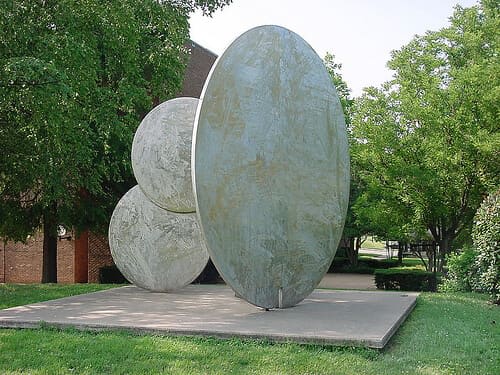
American artist Melvin Edwards (b.1937) is a notable contemporary sculptor whose sources are diverse. Southern Sunrise (1981) is a large-scale stainless steel work measuring 2' 1" x 16' x 16'. Commissioned for the Winston-Salem campus, it is truly an environmental work, reflecting the sun and elements. The sculpture is resonant of African artistic tradition as well as the modern western monumental sculpture. Edwards is esteemed for his politically charged Lynch Fragments series of over 200 sculptures divided into subseries between the years of 1963-1967, 1973-1974, 1978 to the present. These images evoke memories of the African American experience of the injustice of slavery. To make these remarkable works, Edwards welded metal objects such as hammers, scissors, chains, railroad splices, locks into assemblages. Southern Sunrise is outstanding example of Edward's monumental practice.
17. Durga Battling the Buffalo Demon
Emory University, Georgia
Sculptor: Unknown (Made for a temple in Rajasthan, India)
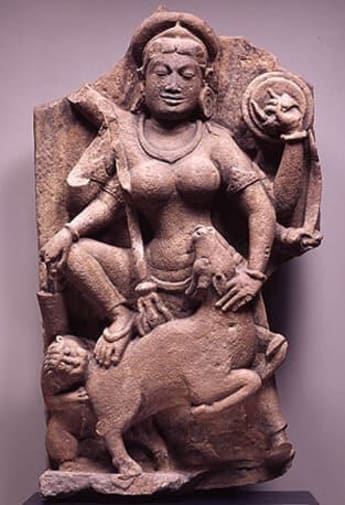
This finely carved sandstone relief sculpture is from a side of a temple in Rajasthan, India. Illustrating the myth of the god Mahisha (the buffalo-demon of illusion), the artist depicts the goddess Durga (Devi) overcoming Mahisha after he had defeated all the gods. In gratitude, the gods present Durga with their weapons. Here the illustrious goddess is shown in the triple pose, peacefully conquering the demon. An unusual example of the lyrical and sophisticated carving technique of Indian sculpture, this work is just a fragment of an entire temple, and as such provides a glimpse of the artistry of the ninth century India.
16. Peacock as One
Deloitte University, Texas
Sculptor: Gabriel DiShaw
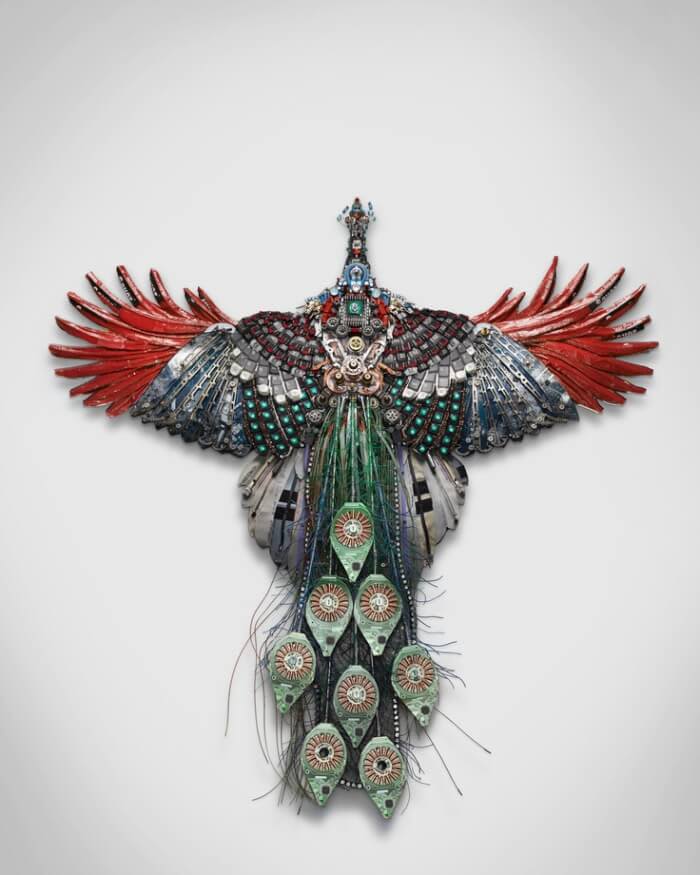
Peacock as One (2012) was commissioned for the cover and interior art of an issue of Deloitte Review. A highly original and adept craftsman, Gabriel DiShaw, is a self titled "Junk Artist" based in Texas who uses found objects including discarded technology, such as computer parts, as a way of imaginatively reusing refuse and up-cycling instead of contributing to landfills. This work and many others in the artist's oeuvre are exceptionally dexterous and inventively made, captivating the viewer with the attention to detail and beautiful design. This work in particular is reminiscent of Pre-Columbian artwork as well as Native American costumes. After publication in the Deloitte Review, the artwork was moved to Deloitte University, where it now occupies a spot of honor in the boardroom area of the university.
15. Nuclear Energy
University of Chicago, Illinois
Sculptor: Henry Moore
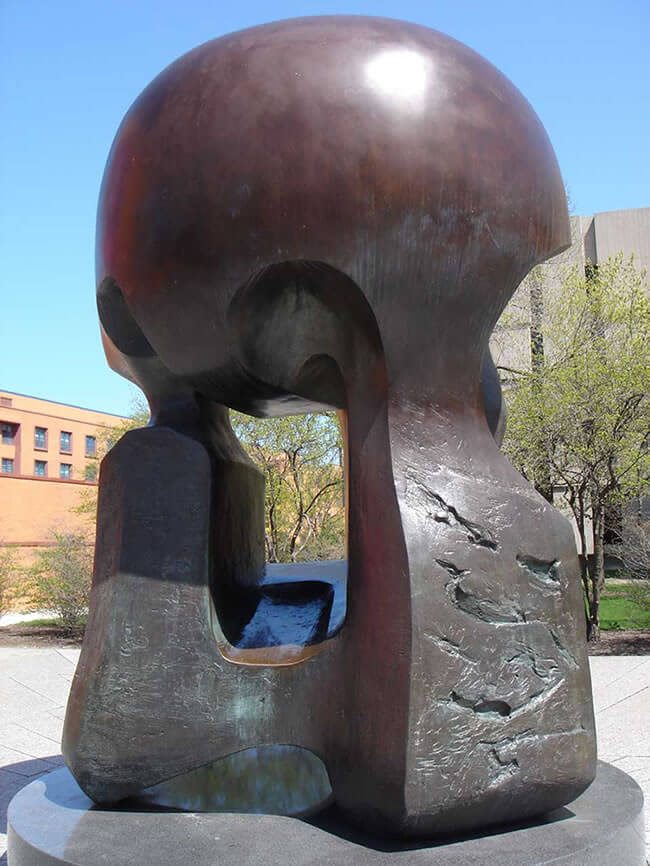
The celebrated British sculptor Henry Moore (1898-1960) has influenced generations of artists. Moore's figural experimentation often followed patterns of the natural world, reflecting and mirroring the curves of mountains and hills. Nuclear Energy (1964-1967) is a bronze cast from a working model of 1963. Moore was commissioned by the University of Chicago to build a sculpture to mark the first controlled nuclear chain reaction that took place in 1942. There are seven casts, one of which was purchased by the city of Hiroshima, Japan. According to the artist, Nuclear Energy (1963) is meant to express "a contained power." Its shape is like mushroom cloud, a human skull, and the lower section recalls cathedral architecture.
14. Maya sculpture Figure of a Dignitary
Princeton University, New Jersey
Sculptor: Unknown (Mayan Classic Period)
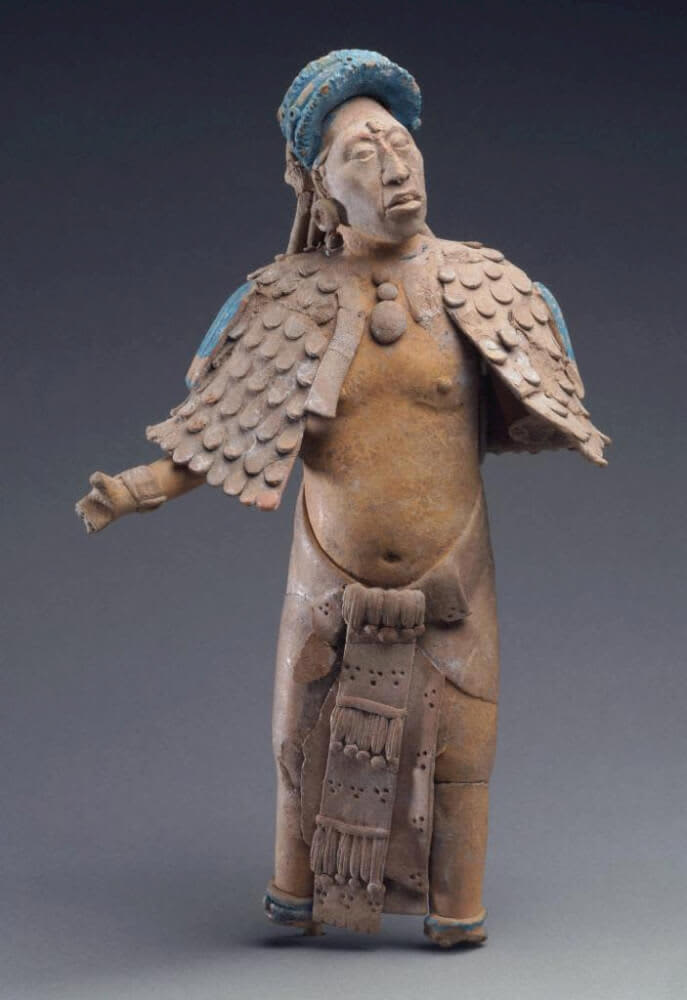
This late classic Maya Sculpture Figure of a Dignitary (A.D. 600-800) is an intriguing example of a period of significant artistic and cultural development in Mayan history. It is made of painted clay and measures 10 1/2 x 6 1/8 x 2 15/16 inches. The artist represented what is thought to be a court singer. Such figures have been found in Mayan burial sites.
13. Jacob's Dream
Abilene Christian University, Texas
Sculptor: Jack Maxwell

American artist Jack Maxwell designed Jacob's Dream in 2006 for the centennial at the Abilene Christian University. It stands 34 feet tall, and includes a large round baptismal pool. There are also four bronze angels, and elemental rocks, water and plants as well as engravings of scriptures. According to the artist, the footprint reflects the trinity. The work is a beautiful amalgam of archaic references including stones evocative of classical ruins and bronze figural sculpture, reminiscent of nineteenth century civic sculpture. Maxwell is a Former Chair of ACU Art and Design and the work was built in cooperation with several students and Maxwell's wife Jill.
12. Resonance
Princeton University, New Jersey
Sculptor: Kendall Buster
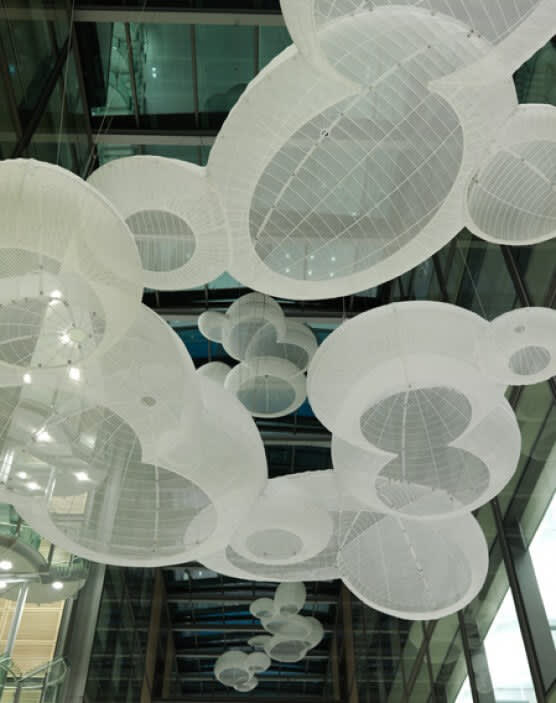
This large-scale site-specific work is suspended from the seventy-five foot high glass roof of the Frick Chemistry Laboratory. It is an architectural embodiment of biology made of fourteen orbs made of steel and shade cloth. The translucent shapes are reminiscent of the view seen through a microscope lens. Buster (1954-) studied microbiology in college and worked as a lab technician. Made in 2009, it reflects the artist's interest in science as well as the mission of the laboratory.
11. Millennial Time Machine: A Landau Carriage Converted to a Mobile Camera Obscura
University of British Columbia, Canada
Sculptor: Rodney Graham
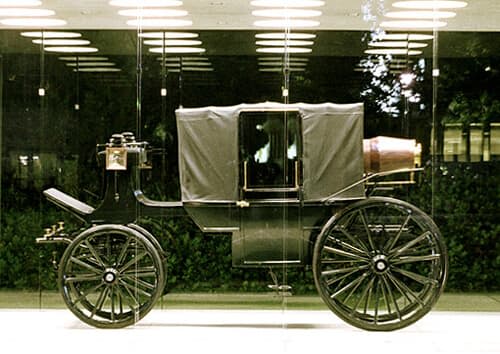
Canadian artist Rodney Graham (b.1949) created Millennial Time Machine: A Landau Carriage Converted to a Mobile Camera Obscura in 2003. The work is made using a nineteenth century horse drawn landau, and a camera made into a camera obscura. The visitors can see the landau inside of a glass pavilion and it serves as an allegory for the mission of a university as the center for innovation. The work is a variation on Graham's 1979 interpretation of Leonardo's camera obscura. Graham is a conceptual artist who also makes films and draws upon a variety of sources including poetry, literature, and opera.
10. Homage A Debussy
Washington University, St. Louis, Missouri
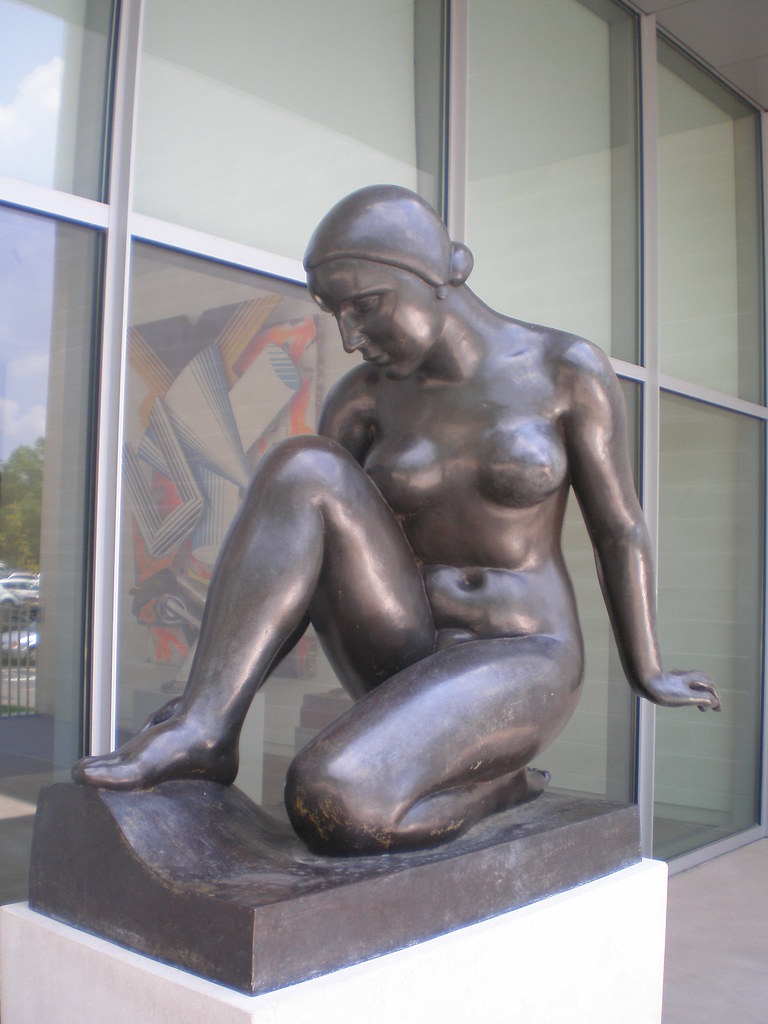
Sculptor: Aristide Maillol
French artist Aristide Maillol's (1861-1944) alluring sculpture was cast in bronze and measures 35 x 20 x 37 inches. Maillol depicts his favorite model Dina Vierny, a young woman who inspired many other artists including Henri Matisse and Pablo Picasso. Vierny was very much admired for her bravery as a Freedom Fighter, although she was imprisoned by the Nazis for a period of time. Clever and resourceful, it is said that she managed to convince the Gestapo she was innocent of any suspicious activities. Despite this ingenuity, she told the sad tale of singing to a fellow prisoner before he was executed. Vierny would go on to become an art dealer and the director of the Musa e Maillol. This sculpture, Homage A Debussy, was given to the university by the important St. Louis collector Morton D. May. It is a fine example of Maillol's graceful sensuality. Not only does this work depict an interesting historical figure it is also reflects the inheritance of modernist sculpture.
9. The Tropical Gardens
New York University, New York
Sculptor: Louise Nevelson

American artist Louise Nevelson (1899-1988) is a highly thought of sculptor of abstract assemblages, whose sculptures are often made of found objects, and/or architectural elements. Her unique juxtaposition of artifact like materials, anonymous spaces, and monochromatic structures form the basis of a distinctive style. Constructivist works such as Tropical Gardens (1957) were often composed of stacked compartments containing enigmatic objects. Tropical Gardens is related to Nevelson's series of all black works, and is made of painted wood, measuring 99 x 133 1/8 x 9 inches. Its form refers to the Christian altarpiece format, the influence of non-western totemic art, as well Cubism. The minimalist simplicity of Nevelson's work is remarkable. Her style is almost always recognizable and has never been replicated with such formal success.
8. The Gates of Hell
Stanford University, California
Sculptor: Auguste Rodin
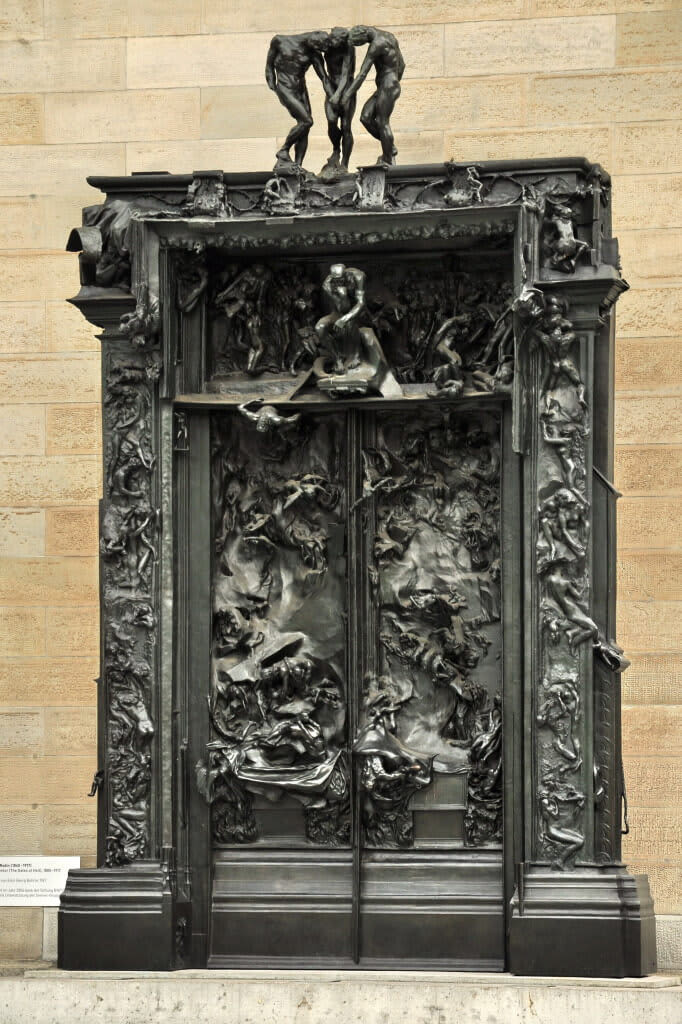
Long considered perhaps the most famous European artist, Frenchman Auguste Rodin (1840- 1917) is the widely acclaimed master of modern sculpture. His influence on all types of sculpture is far reaching and engendered experimentation in both figural and abstract art in all mediums. This work, The Gates of Hell (1880-1900) was cast in 1981 in bronze by the Coubertin Foundry, no. 5., and it is a posthumous cast authorized by Musã e Rodin, and stands 636.9 x 401 x 84.8 cm. The history of this work began with Rodin's commission to design a set of monumental doors of a new decorative arts museum planned by the cultural ministry. Rodin chose Dante's Inferno as the theme as an allegory for contemporary moral problems and also referred to Lorenzo Ghiberti's bronze doors for the Bapistry of the Florence Cathedral. The project was cancelled but Rodin was so engrossed in the subject he continued to work on variations of the theme for two decades. The work is one of many posthumous casts at the university.
7. Stacks
Yale University, Connecticut
Sculptor: Richard Serra
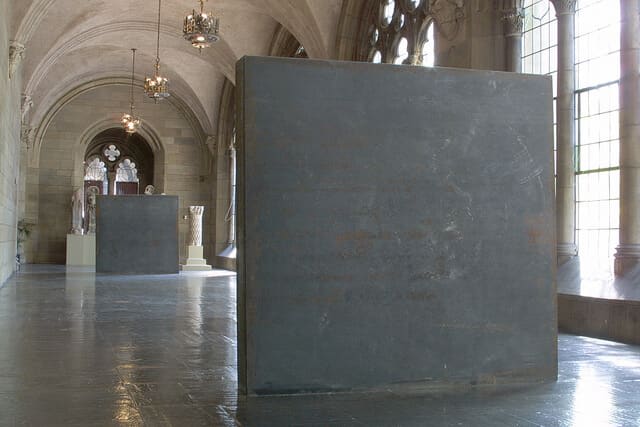
Stacks (1990) is made of two cubes of steel measuring 93 inches high x 96 inches wide x 10 inches deep. Drawn in by a sense of magnetism between the two steel pieces, the visitor can walk between the structures. The leading contemporary artist American artist Serra (b.1939) has produced numerous site-specific works in a grand scale in a reductionist or minimalist vein, often creating industrial looking works that defy gravity. He is considered among the most distinguished contemporary sculptors in the world and his technical prowess is world renown.
6. Standing
University of California, San Diego, California
Sculptor: Kiki Smith
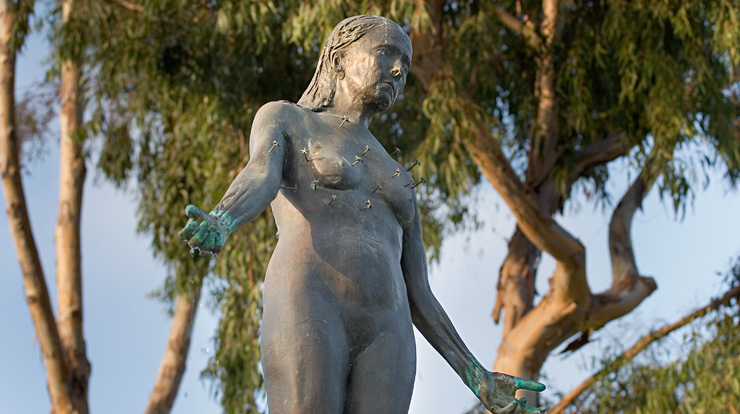
German-American artist Kiki Smith (b.1954) is a prominent contemporary sculptor who is most well known for what is often considered a shocking interpretation and depiction of the human body. This cast bronze work is also full of the unexpected. It is a classical figure, yet its skin is punctuated to reveal anatomy; her hands generate water that pools into the rock pool below; and she stands on a tree trunk, cast from a dead tree on the university campus. The sculpture was cast from a live model, and the work like so many of her installations and sculptures reflects an interest in the generative concept of the human body, our tie to the natural world and the cycle of life. Long characterized as "abject," Smith's work in fact, forces us to confront our earthly selves, something so often sanitized and portrayed as static. This work is installed between the Medical Teaching Facility and the Basic Science Building.
5. Ogbo Elegba (dance staff for Eshu)
University of Iowa
Sculptor: Unknown (Yoruba People, Nigeria)
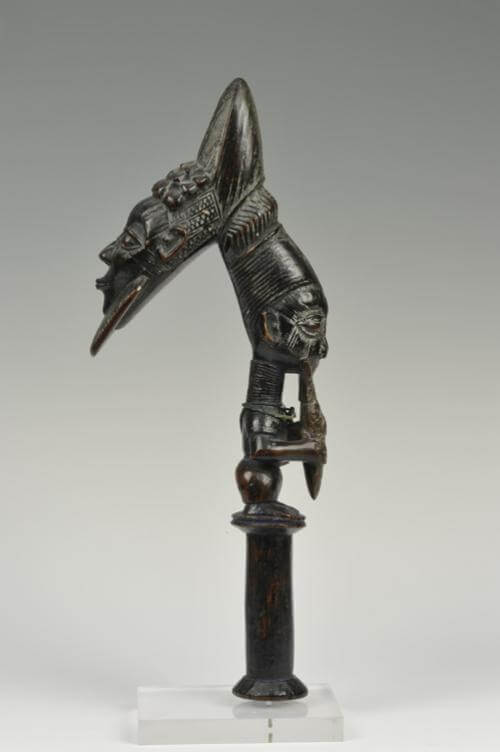
The Ogbo Elegba (H. 41.8 x W. 7 x D. 16.5 cm) is one of many fine examples of African art in the University of Iowa Museum of Art. Made by the Yoruba people of Nigeria, this is a hook (garabato) and its purpose was to be worn by the priests of the cult of Eshu (Elegba, the trickster). These hooks would be used in dance ceremonies, or when a priest was inhabited by the God. As with many objects that are used in ceremonial capacities, this work represents more than aesthetic beauty or style, but also a process or ritual of a religion.
4. Eyes
University of Texas
Sculptor: Louise Bourgeois
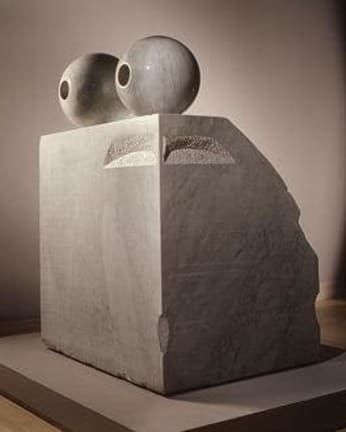
An exceptionally imaginative and adroit artist, the French sculptor Louise Bourgeois (1911-2010) once said the purpose of art was "to express emotions." An icon of modernism and in particular, the feminine voice in the visual arts, she is regarded as one of the most important abstract sculptors. Much of the Bourgeois' work is based on personal experiences, and issues of universal concern such as motherhood, birth, gender and sexuality as well as memory. Her art was a cathartic experience, an expression of emotions and ideas. In addition to her notoriety for her spider sculptures, Bourgeois is most well known for her psychologically disturbing and expertly carved sculptures of disarticulated body parts. Eyes (1982) carved when the artist was 72, measures 74 3/4 x 54 x 45 3/4" inches and is reminiscent of the techniques of Michelangelo and Rodin, particularly in the contrast between the carved and chiseled exposed raw stone. The work also draws upon the vocabulary of Surrealist art to form a style unlike that of any other artist.
3. Mlle. Pogany II
Yale University, Connecticut
Sculptor: Constantin Brancusi
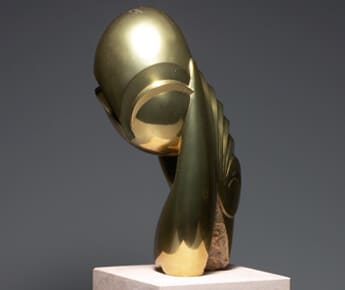
The influential artist Constantin Brancusi (1876-1957) was born in Romania, was active in France, and has long been thought of as one of the most important modern sculptors. His works are singular interpretations of fluid simplified forms, tied to Romanian wood carving and African art, and focusing on contrast of various smooth textures and ovoid forms. This work Mlle. Pogany II (1919, cast in 1925) measures 17 1/8 x 7 1/16 x 11 1/4 inches and is very rare, as there are very few of Brancusi's works in existence today, and it is a truly wondrous example of the artist's talent. In this work, we can see Brancusi's use of contrasting natural materials with polished metal sculpture and the reinterpretation and oblique references to "primitive sources." There are other versions of this sculpture including a stone and a plaster version.
2. The Percy Bysshe Shelley Memorial
Oxford University, England
Sculptor: Edward Onslow Ford

This seductive sculpture (1892) carved by the gifted British sculptor Edward Onslow Ford (1852-1901) has proven to fascinate countless visitors throughout the years. In an extraordinarily skilled manner Ford depicts the drowned poet, washed up on shore. The figure is at once languid, sensual, and tragic. Originally commissioned by Shelly's daughter-in-law Lady Jane for the poet's grave in Rome, it was donated to Oxford, as it was too large for the cemetery. Ford's work draws on Greco-Roman influences as well as the tradition of Michelangelo, and as was his habit, evokes a sense of a melancholy and beauty. Ford was a renowned sculptor of busts, allegorical figures, as well as monuments.
1. Front House Totem Pole, Haida Village
University of British Columbia, Canada
Sculptors: Bill Reid and Douglas Cramner

The leading Haida artist Bill Reid's (1920-1998) totem pole (and the related group of works) was chosen as the most interesting sculpture at a university because it is an experiential masterpiece, a testament to the accomplished arts and crafts traditions of the people of First Nations. As an historic reconstruction, it offers historic, aesthetic and archaeological education. It is a rejuvenation and preservation of a rich culture often obscured and or ignored. The legacy of this project is far-reaching ]not only in terms of modern art, but also the understanding and preservation of North American history.
In 1959, Reid was invited in recreate a model of a Haida village at the University of British Columbia. In cooperation with his assistant, Kwakwaka'wakw artist Douglas Cranmer (1927-2006), Reid completed a complex including two houses and seven poles. The featured sculpture itself is a Totem Pole at the front of a mortuary house. Various creatures are depicted, including a watchman, a hybrid raven, a man with man-bird face on the tail, a bear with a raven between its legs, an amphibian creature with an insect, a bear with a frog, a wolf and a cub. The leading Haida artist Bill Reid (1920-1998) was a pivotal figure in the study and promotion of Native culture and arts, and a masterful sculptor. With this project and many other fine works, Reid was essential to the bringing a consciousness of First Nation art to the North American public. Depictions of his famous sculptures are on versions of the twenty-dollar Canadian bill including The Spirit of Haida Gwaii, The Raven and the First Men, Mythic Messengers, Xhuwaji, and the Haida Grizzly Bear.